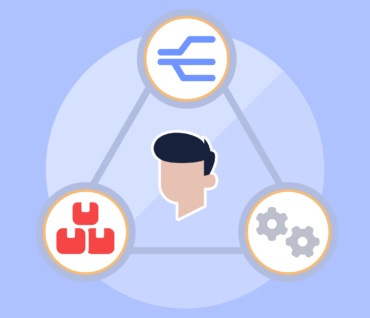
Get Started
Graphite's supplier management tool helps you onboard faster, cut time on risk reviews and streamline supplier validations. Save time and money.
January 19 2023
Being a Gatekeeper in Vendor Management: Maximizing Supply Chain Resilience by Preempting Risks
For supply chain leaders, the procurement team plays a crucial role in managing supplier risk. Overlooking this responsibility can have severe financial repercussions for your company. By transforming your team into adept gatekeepers within vendor management you will add significant value to your organization.
Every supplier integrated into your company operations and supply chains brings associated risks, and it’s imperative for your procurement team to effectively mitigate these risks. If your organization lacks a robust supplier risk management strategy, this could open the door to potential disruptions and costly errors.
What Is Supplier Risk Management?
Supplier Risk Management (SRM) is the critical process of identifying, analyzing, and addressing the risks associated with your suppliers. This means that it is natural for the existence of gatekeepers in vendor management. The risks that these vendor management gatekeepers monitor range from data breaches and operational failures to various other business disruptions that can impact your suppliers’ capacity to deliver, and in turn, significantly affect your organization’s ability to provide products and services to your customers.
If your gatekeepers in vendor management can effectively manage supplier risks, safeguarding your business operations and maintaining a steady flow of goods and services to your customers will become easier.
Why Is Having Gatekeepers in Vendor Management Critical?
Gatekeepers in vendor management are crucial for ensuring resilience, compliance, and operational efficiency in an increasingly complex global business environment. The goal of SRM is to minimize the potential for unforeseen issues and supply chain disruptions that can arise from supplier-related problems.
By effectively managing supplier risks, you can:
1. Protect your organization from financial losses
2. Maintain compliance with regulations
3. Safeguard your company’s reputation
4. Avoid supply chain disruptions
5. Ensure continuity of operations
So, what is it that gatekeepers of vendor management really do? What are their goals and responsibilities? Let’s see in the next section.
How to Become an Expert Gatekeeper in Vendor Management?
The initial step in effective supplier risk management is to identify key suppliers that pose the greatest risk exposure. Then begin establishing a comprehensive supplier risk assessment process.
Focus on pinpointing the most critical risk areas specific to your operations. For instance, engaging a software company as a supplier typically presents higher third-party risk compared to less technology-centric suppliers like window washers. Each organization is unique, and understanding the specific supplier risks is vital to shielding your business from potential threats.
In crafting your risk management plan, consider integrating elements like supply chain visibility, supplier relationship management, supplier lifecycle management, and supplier performance evaluation. This approach not only helps to mitigate risk but also ensures supply chain operations are streamlined and resilient. Remember, effectively managing supplier risk is key to maintaining robust supply chain operations and preventing disruptions.
Consider each of the following categories as you develop your supplier risk management strategy:
Financial Risk Management
Financial risk in supply chains comes in various forms, and it’s crucial for procurement teams to vigilantly manage these risks. A primary concern is the reliability of a supplier’s ability to fulfill contractual obligations. For instance, an off-shore raw materials supplier responsible for delivering rubber may fail to meet its commitments, posing significant financial risks.
Moreover, safeguarding your company’s financial data is paramount, especially when suppliers have access to customer information. It’s essential to assess the security of a supplier’s systems to mitigate the risk of financial data breaches. Any lapse in this area could lead to substantial financial losses for your company and for your customers.
Another aspect of financial risk management is the scrutiny of potential fraudulent financial information from suppliers. Conduct thorough assessments of each supplier’s source-to-pay tools to verify their credibility and accuracy. This step is critical in supplier risk assessment, ensuring that your company avoids potential financial pitfalls.
Cybersecurity Risk Management
In today’s digital world, cybersecurity stands as a key risk for businesses. It’s essential to continuously monitor cybersecurity threats, particularly when engaging with suppliers who have access to your databases or sensitive customer data. The procurement team plays a vital role in managing these risks during the supplier onboarding process.
It’s crucial to conduct a thorough assessment of the cybersecurity measures of each supplier. This involves evaluating their data protection protocols, their compliance with relevant cybersecurity laws, and their ability to respond to potential cybersecurity incidents. This level of scrutiny helps mitigate the risk of data breaches and ensures the safety of both your company’s and customers’ information.
Additionally, it’s important to consider how to best manage these supplier relationships throughout the lifecycle. Regular reviews and updates of cybersecurity strategies should be a part of your ongoing supplier management process. This proactive approach not only safeguards against immediate threats but also builds resilience against future cybersecurity challenges.
By prioritizing cybersecurity in your supplier risk assessment and management strategies, you effectively protect your business from the ever-evolving landscape of digital threats.
Compliance Risk Management
For procurement professionals, safeguarding against compliance risk is crucial. It’s important to collaborate with your legal team when you are evaluating how your company’s operations align with national compliance laws. This partnership ensures your procurement processes adhere to legal standards, effectively mitigating any potential risks.
Supplier compliance risks can vary widely across industries. For example, banks are subject to stringent financial regulations, while construction companies must adhere to environmental and safety standards, like stormwater drainage laws.
When onboarding new suppliers, it’s essential to evaluate whether they have the necessary systems and processes in place to comply with these diverse legal requirements. Suppliers who don’t follow compliance requirements can pose a significant risk to your company.
Supply Chain Risk Management
In procurement, it’s imperative that your team understands and manages supply chain risks. As mentioned above, there is always the risk of a partner company failing to deliver. When evaluating potential business partners, understand the performance risks. Are there robust systems in place to ensure the contract is upheld? Does that company properly vet its suppliers?
Remember that the various risks posed to your business can extend beyond what you may think to assess. Be sure to analyze as much of your entire global supply chain as possible. This deep-dive approach not only identifies potential disruptions but also evaluates third-party risk at various stages of the supply chain.
Ensuring that your company’s supply chain is robust and secure involves more than just assessing immediate suppliers; it requires a holistic view of the entire network. Graphite’s central network offers complete stakeholder visibility into the entire supplier lifecycle with automated risk assessments and remediation plans to help keep your supplier collaboration and procurement operations on track and moving smoothly.
Social Risk Management
Social risk is an increasingly important aspect of risk management, and includes political, environmental, ethical, and diversity issues. Given procurement’s key role in dealing with suppliers, it’s crucial to assess how you align with these social risk factors to achieve corporate social responsibility objectives.
Associating with suppliers involved in unethical practices, like child labor within their global supply chains, can significantly harm your organization’s reputation. Such issues, once publicized, can lead to customer boycotts and widespread backlash.
In general, it’s crucial to build a foundation where your team is trained to have a keen eye and specific process for risk monitoring and that each team member understands how to mitigate and manage that risk. When you have strategies that consider each risk factor, this becomes much easier and more efficient.
Leveraging Third-party Risk Data
It’s likely that your organization doesn’t collect all the data you need to fully evaluate a supplier’s risk. To mitigate that issue, your team can leverage external risk data sources to collect more information about suppliers. These sources cover a myriad of risk topics, to give you the insight you need to make an informed decision about a supplier.
Depending on the supplier risk management software you use, you may be able to integrate these third-party data suppliers into your existing systems for ease of use. For example, Graphite integrates with third-party data sources and combines it with your existing supplier data to create a holistic view of your suppliers and feed all your risk and due diligence data into a single viewpoint.
Now You Know How to Be a Great Gatekeeper in Vendor Management. What’s next?
Now that you’ve become a skilled risk gatekeeper in vendor management, what next? You could consider upgrading to a comprehensive supplier risk management solution that will allow you to centralize your processes and keep supplier data, including risk information, up to date? Graphite Connect is the solution for you. The Graphite platform allows you to customize your supplier intake process and centralize where your supplier data is stored and updated–simplifying operations and protecting your company like never before.
Ready to level up?
When you’re ready for a world-class procurement platform, Graphite is here to help. Learn how our advanced network architecture can help you to eliminate tedious redundancies, manage supplier risk, and increase the impact of your team. Request a demo today to see the full power of Graphite for yourself.
Read More



